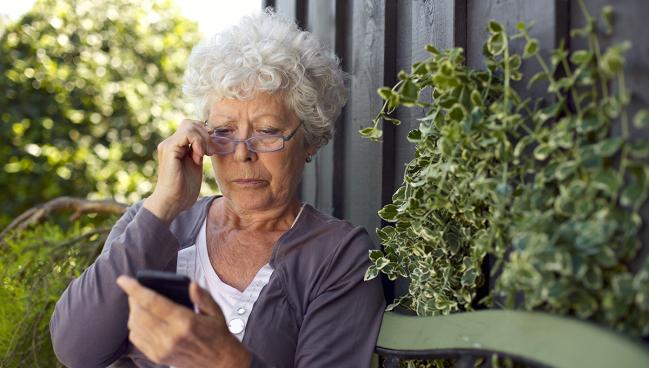Need a Statin for Primary Prevention? There’s an App for That
The technology is part of a broader push to make rosuvastatin 5 mg available OTC, a push that’s felled other statins before.

ATLANTA, GA—More than 90% of patients get it right when it comes to appropriately selecting themselves as candidates for over-the-counter statin therapy, according to results from the TACTiC study.
Importantly, people who correctly self-identified for a moderate-intensity statin and who appropriately took the medication for 6 months had a clinically meaningful reduction in LDL cholesterol, researchers reported this week at the American College of Cardiology 2024 Scientific Session.
“The thing that surprised me most about this result is that these people, because they were self-motivated, were very adherent,” lead investigator Steven Nissen, MD (Cleveland Clinic, OH), told TCTMD. “By pill count, the adherence, at least for 6 months, was 95%. People reordered the drug. They had the option to not reorder it. Now, is it a 5-year, study? No. But every patient who should be on a statin that's not, that we can get on a statin even for modest periods of time, is likely to make a difference.”
The technology-assisted self-selection program, which is embedded within the app, has been developed by AstraZeneca as “software as a medical device” based on guidance from the US Food and Drug Administration. The plan is to submit these data to regulators so that people could assess their own eligibility for statin therapy and, if appropriate, start rosuvastatin 5 mg without a physician’s prescription. The drug would be sent directly to their home, bypassing the doctor’s office and pharmacy.
“I hope that if this is widely available, it will be used, and it will help a lot of people, some of them uninsured, some of them who live in rural areas where they don't have good access to physicians,” said Nissen. “It would allow them to take a statin when they should.”
I am terribly troubled that we have a life-saving class of drugs that isn’t being used by half the [primary-prevention] population. Steve Nissen
This isn’t the first time a company has tried to make a statin available over the counter (OTC). While simvastatin 10 mg has been available OTC in the United Kingdom for 20 years, the FDA has steadfastly refused to make lovastatin 20 mg available without a prescription, shooting drugmaker Merck down in 2000, 2005, and 2007. Pfizer abandoned their plans to make atorvastatin available OTC in 2015 based on data showing that people didn’t use the drug correctly.
Historically, Nissen has been against OTC statin therapy, speaking out against Merck’s attempts with lovastatin in particular. Back then, the data put before the FDA showed that the “wrong people, the worried well” were getting it as opposed to those who needed it, he said. “Their ability to self-select based just on the drug label was way below 50%,” said Nissen. “That’s not good enough. We thought we could do better with the app and we did—we did a lot better.”
OK to Use
With the web app, eligibility for statin therapy was based on the 10-year risk of atherosclerotic cardiovascular disease (ASCVD) using the pooled cohort equations of the 2018 cholesterol treatment guidelines. People put in their total cholesterol, LDL, and HDL levels and were asked several questions about concomitant medication use, such as if they were taking cyclosporine or warfarin, as well as questions about prior history of heart attack, stroke, peripheral artery disease, or “procedures on your heart.” Possible outcomes included “OK to use,” “ask a doctor,” and “do not use.”
The study enrolled 1,196 participants (mean age 63 years; 60.4% male) able to understand English and with access to the internet. Mean LDL cholesterol at baseline was 139.6 mg/dL, and the median 10-year risk of ASCVD was 10.1%.
After responding to the advertisement, participants were interviewed virtually by a healthcare practitioner blinded to the participant’s self-selection to assess eligibility for rosuvastatin 5 mg. For this first co-primary endpoint, which was based on the initial assessment, concordance between consumers self-selection for eligibility and clinicians was 90.7%.
If statin therapy was considered appropriate, rosuvastatin was delivered to the home. Participants were asked to again assess eligibility using the web app and to have a second virtual visit with a healthcare provider. For this second co-primary endpoint, 98.1% of consumers had final-use assessments concordant with the clinician during the 6-month treatment period.
Are we making sure we’re not propagating a digital and information divide? Thomas Maddox
The mean change in LDL cholesterol from baseline, which was assessed prior to the second visit with the healthcare provider, was 35.5%. The final LDL-cholesterol level was 88.1 mg/dL, with 85% of participants lowering LDL by at least 20% from baseline. The rate of adverse events leading to drug discontinuation was 7.1%, including 3.1% who stopped the drug due to musculoskeletal disorders. The rate of myalgia was low (4.1%).
‘Digital and Informational Divide’
Nissen said with less than half of primary-prevention patients taking statins to reduce the risk of ASCVD, there is a need for “innovative” approaches to close the treatment gap. The web app, he said, could help expand access, but other approaches for safe access will be needed for those who are unable to use the technology.
Thomas Maddox, MD (Washington University School of Medicine in Saint Louis), said TACTiC plus the 500-patient implementation study published in 2021 “go a long way” to address concerns the FDA has historically had with OTC statins.
“I also think it’s a wonderful example of creating a partnership with our patients,” he said. “This is a modern platform that really allows us to continue that conversation and engagement with our patients, and frankly empower them to take more control of their health. Going through a process like [the app] will surface in them a need to be thinking about cardiac risk and measures they can take.”
Patients, even the elderly, are actively engaged with digital technology and the healthcare system should be able to also meet them in a “digital way.”
While the app and OTC statin use can help increase the number of eligible patients taking statins, Maddox does worry about the selection characteristics of patients in the TACTiC trial, wondering if the technology is reaching those who really need risk modification. Most patients had a college education and were highly literate around their healthcare needs, including their medical history. Maddox also wondered if the web-based technology might put too much onus on patients to collect their own lab values for things like LDL and total cholesterol.
“It speaks to an equity question,” he said. “Are we making sure we’re not propagating a digital and information divide?”
To TCTMD, Nissen noted that if patients didn’t know their cholesterol numbers but wanted to be part of the study, they were directed to a pharmacy where the test could be done. He agreed that while not everybody might be able to use the technology, he argued it’s a step in the right direction towards reducing the treatment gap in primary prevention. “I am terribly troubled that we have a life-saving class of drugs that isn’t being used by half the population,” he said. “We’re really not getting the job done in primary prevention.”
Michael O’Riordan is the Managing Editor for TCTMD. He completed his undergraduate degrees at Queen’s University in Kingston, ON, and…
Read Full BioSources
Nissen SE, Hutchinson HG, Wolski K, et al. Actual use evaluating a technology-assisted web application for consumer access to a nonprescription statin._J Am Coll Cardiol._ 2024;Epub ahead of print.
Disclosures
- Nissen reports clinical trial research support from AbbVie, Arrowhead, AstraZeneca, Bristol Myers Squibb, Eli Lilly, Esperion, Medtronic, New Amsterdam, Novartis, and Silence Therapeutics (all honoraria, speaking, or consulting fees paid to charity).






Comments